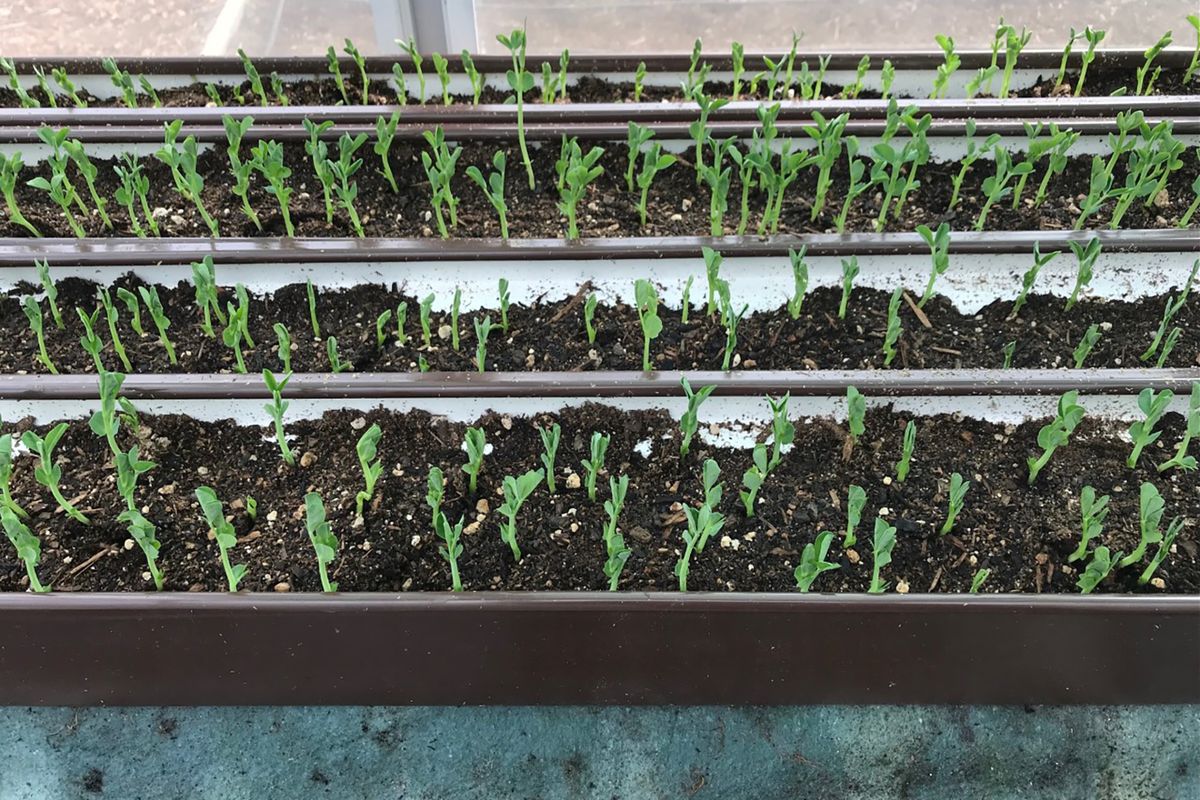In the Garden: Help peas get a good start in the gutter

For the past three years, I’ve started my pea crop by using the “gutter pea” technique. I know that doesn’t sound very appetizing, but it is a great method for sowing and transplanting them.
Most gardeners plant their pea seeds directly in the garden with no problems at all. I, on the other hand, have had to get creative due to two challenges: California quail and unpredictable spring weather.
Quail love to nibble on my freshly sprouted pea seeds, which certainly impacts my chance for having a productive pea patch. Additionally, choosing the correct date to plant the seeds in early spring can be a guessing game. If the weather suddenly turns particularly cold and wet, very few seeds will sprout.
After a couple of years of disappointing results, I began starting my pea seeds indoors ahead of time using a 72-cell planting flat. The germination rate was always excellent because of the controlled conditions. Two weeks later, I’d plant them outdoors while going through the tedious process of extricating individual seedlings from the flat, digging a hole for each and planting them one by one.
My routine changed four years ago after watching videos of a British gentleman in his allotment garden. When he started talking about his gutter peas, I was intrigued. He planted the seeds in rain gutters, which he kept temporarily inside a small greenhouse.
As he explained, U.K. gardeners have problems with mice eating their pea seeds. By getting them started ahead of time, this resolved the problem. At the appropriate time, he slid the seedlings out of the gutters into his garden bed. What really got my attention was how he was able to plant so many seedlings in about two minutes. I was convinced.
Since I grow two rows of peas in an 8-foot-long raised bed, I bought two sections of vinyl rain gutters from a local home center. They cost less than $5 each and will last a very long time. Using a hacksaw, I cut each one into two 4-foot lengths for easier handling. It’s possible to purchase end caps for them, but I make temporary ends with cardboard and tape them in place.
I plant the seeds indoors around March 10. After filling the gutters with pre-moistened seed-starting mix, I plant a double row of seeds in each one with a goal of getting a thick stand of seedlings. I place them on a plastic tarp inside our south-facing sliding door.
The seeds germinate quickly, which is a nice change from starting them outdoors. I frequently monitor the moisture in the seed-starting mix so it doesn’t dry out.
Once the plants begin growing, I start the hardening-off process. This involves putting them outside in filtered sunlight for an hour the first day, then moving them back indoors. On the second day, they are outside for two hours. I keep increasing the time until I can plant them in the garden.
I mentioned how the allotment gardener slides his pea seedlings into a garden bed so easily, but quickly learned there are some tricks to that. The first step is to allow the seedlings to develop a thick mat of roots, which takes a good three weeks.
On planting day, I dig two long trenches in the bed that are the depth of a gutter and spaced at least 2 feet apart. Next, I water the soil in the gutters until it’s dripping wet. That way, the peas will slide out of the gutters and into the trench.
To plant the peas, I remove the end caps from the gutter and place one end at the beginning of the trench. Then I raise the other end of the gutter to 45 to 70 degrees and jiggle it a bit to get the peas, their root mass and the soil to start sliding out
I slowly guide the plants into the trench while keeping the gutter lifted and moving the lower end along the length of the trench. I can plant two gutters of pea seedlings in about two minutes. It’s also possible to push out short sections of peas at a time but my all-in-one-go method is much more fun.
One last thing: I always provide pea vines with supports to grow on. Some seed packets indicate certain types of peas don’t require support. I beg to differ. If you want to keep them from falling into a heap that is a nightmare to harvest, give them something to climb on. I use pruned branches from our small orchard. They’re free, and they look really cool.
Susan Mulvihill is author of “The Vegetable Garden Pest Handbook.” She can be reached at susan@susansinthegarden.com. Watch this week’s “Everyone Can Grow a Garden” video at youtube.com/susansinthegarden.